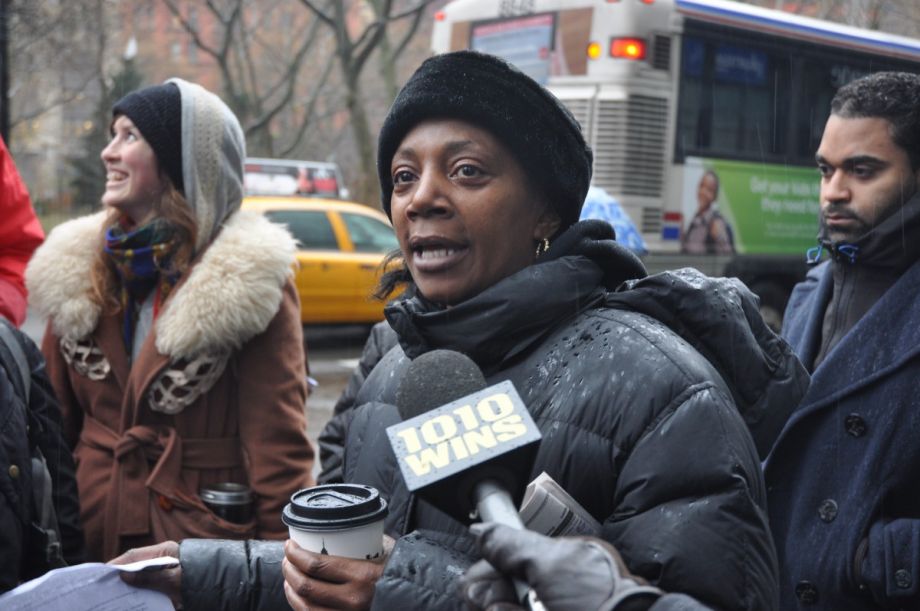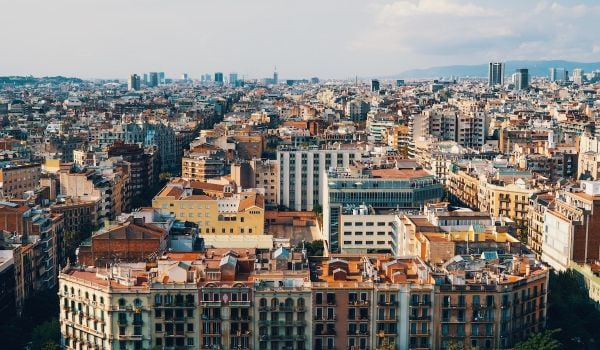It was nearly four weeks since Hurricane Sandy hit New York City, and the weather still seemed to be conspiring against the residents of Brooklyn’s Red Hook Houses public housing development. As Sheryl Braxton, June Clark Smith, and other neighborhood organizers gathered for a rally in front of the New York City Housing Authority offices in lower Manhattan on Tuesday, a cold, stinging rain began to pick up.
The group was small, a couple of dozen or so. Passersby hurried on their way without stopping to see what was happening. Even the police were low-key, quietly requesting that the group stand behind metal barricades on the sidewalk before stepping away.
But the weather didn’t deter Braxton when her time came to speak. “Today is the day,” she said, the wind whipping around her. “We are going to speak for all the NYCHA residents. I’m standing here for everyone.”
When Sandy came, residents of New York public housing took the blow harder than most. Several of NYCHA’s projects — in the Rockaways, the Lower East Side, Coney Island and Red Hook — are in the city’s Zone A, which faced a mandatory evacuation order. Residents in those buildings saw their elevators, heat and hot water shut off as a preemptive measure at 7pm the night before the storm rolled in.
When the worst of the weather was over, according to NYCHA documents, nearly 80,000 residents in hundreds of buildings were affected by outages of power, heat and hot water. And because of flood damage, thousands were still doing without those necessities for weeks after the storm, creating what one researcher called “a slow-motion Katrina.”
Grass-roots volunteer organizations such as the Red Hook Initiative and Occupy Sandy stepped in to provide assistance to project residents. (Full disclosure: I did volunteer work for both organizations after the storm.) But many complained that NYCHA wasn’t doing enough. A meeting in Red Hook on November 15, when hundreds of people were still lacking basic services, elicited a lot of anger.
Yet the tone at this week’s rally was hopeful, in part because advocates from Red Hook had been able to meet with NYCHA officials the day before to present a list of demands: Two months of rent credits for affected residents, effective immediately; a moratorium on evictions; independent tests of water and air quality within affected buildings; and a community-led task force on NYCHA recovery efforts. Most impressively, the advocates left the meeting with a commitment from NYCHA to secure a $1 billion chunk of federal disaster relief for public housing.
Community organizer Reg Flowers, who lives in Red Hook but not public housing, said he was pleased that NYCHA had agreed to “sit with us at the table.” He acknowledged that the rally would have had a very different mood had that meeting not taken place. “They’re a huge organization, and the fact that a group of community members got them to the table at all is a success.”
NYCHA’s willingness to negotiate with residents didn’t emerge from a vacuum. It’s part of the rapidly shifting political landscape that is emerging in the post-Sandy era. The public housing projects of New York City, home to some 400,000 residents, have probably never gotten as much sustained attention from the mainstream media — and from middle-class New Yorkers — as they have in the aftermath of Sandy.

The Red Hook Houses experienced weeks of water and power outtages after Hurricane Sandy. Credit: Michael Fleshman on Flickr
“We had a lot of people come down to assist,” said June Clark Smith, a Red Hook Houses resident. Visitors are unusual in the complex of massive brick towers that Smith and about 5,000 other Brooklynites call home. The single largest public housing development in the borough, the houses feel cut off from the rest of Red Hook, though they occupy the geographic middle of the gentrifying waterfront neighborhood, increasingly a destination for artists and professionals seeking views of the New York Harbor. Yet after Sandy, ”even the homeowners from around the development came into the community, Clark Smith said. “They realize there’s good people inside the projects.”
It’s a realization many New Yorkers never have a reason to make. As a native New Yorker, I was brought up to obey a simple rule: Avoid the projects when you can. Don’t even walk on the same side of the street, if you can help it. Definitely don’t walk through a project superblock to get from one place to the other. You never know what might happen.
Post-Sandy, those rules went out the window, at least for a time. It was as if those who live outside of public housing were able to really see these developments for the first time, as the complicated and diverse communities that they really are.
That didn’t mean an end to prejudice against public housing residents. You can see it in the vitriolic comment threads attached to nearly any article about the demands public housing residents are making. Some of the people who showed up to help were clueless and condescending, as well.
But just maybe, the response to Sandy is building something that will carry forward into the future and make New York a stronger place. On a cold and rainy late November morning, it seemed like people were willing to give it a try. “We pulled together,” said Smith. “We want things to continue to get better. This is just the start.”
“What happens in housing affects all of us,” said Flowers. “We understand we’re all connected.”

Sarah Goodyear has written about cities for a variety of publications, including CityLab, Grist and Streetsblog. She lives in Brooklyn.
















